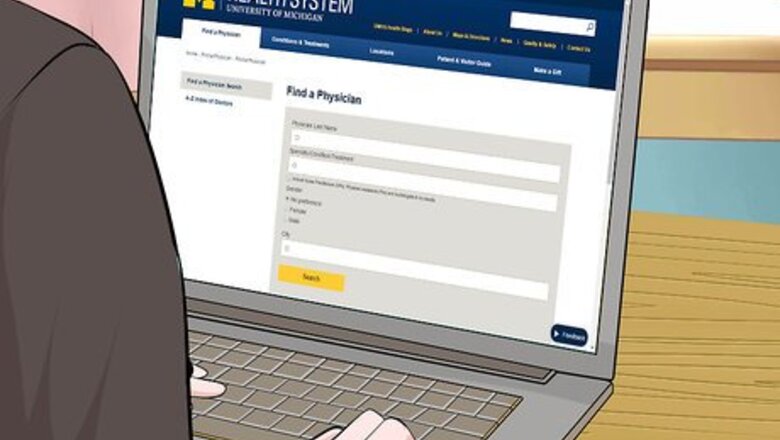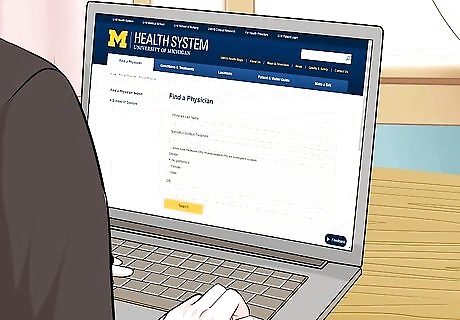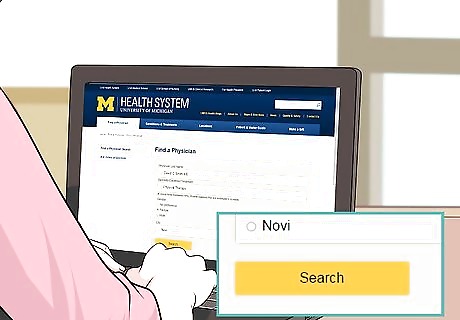
views
Finding a PA to Provide Care

Search in the same manner you use to find a doctor. In the U.S., you are probably a member of a particular “health system” based upon the particulars of your health insurance plan. Health care system websites typically have “find a doctor” search pages, and many of these permit you to search for physician assistants as well. For example, on this health system website, you simply check a dialog box on the search page if you want to include PAs (as well as registered nurses [RNs]) in your physician search.

Search on commercial web portals. In addition to health system websites, there are for-profit sites that list (and often grade) medical providers, including PAs, based upon your selected location and/or other preferences. Enter the metro area in which you want to find a PA, and a long list will likely appear before you. Don’t ignore the PA ratings on such sites, but take them with a grain of salt. It is often difficult to pin down the exact criteria by which such ratings are determined. Use them as a starting point, but not the only determining factor.

Look around in practically any healthcare setting. You might think of physician assistants working in primary care physician offices, but PAs can also be found pretty much anywhere else you might find a physician, performing many of the same services. You’ll find them in hospitals, clinics, nursing homes, schools and colleges, military and government settings, and elsewhere. In all 50 U.S. states, PAs are authorized to take medical histories, conduct exams, diagnose and treat illnesses, order and interpret tests, develop treatment plans, counsel on preventative care, assist in surgeries, write prescriptions, and make hospital rounds.

Recognize the benefits of PA-provided care. Some people may worry that they are somehow getting “second rate” medical care by seeing a PA instead of a physician. However, surveys and studies indicate that PAs provide a similar quality of care and produce similar patient outcomes, while achieving the same degree of patient satisfaction. And remember, PAs always work in collaboration with (and under the guidance of) a physician. PAs help to reduce costs, increase service availability, and decrease waiting times, all while providing comparably effective care. Some patients in fact find it easier to feel at ease and make a personal connection with a PA as opposed to a medical doctor. Once you find the right PA, you can feel confident that you are getting high-quality general medical care.
Finding a PA to Hire

Check the job board on the AAPA website. The American Academy of Physician Assistants (AAPA) is the largest national professional society for PAs in the U.S. The AAPA maintains a “job link” website that helps bring PA job-seekers and employers together. You can search posted job openings as well as uploaded PA resumes. According to the federal Bureau of Labor Statistics, PA jobs in the U.S. are expected to grow by 38% between 2012 and 2022, so there should be no shortage of job openings and an increasing number of freshly-minted PAs for the foreseeable future.

Search other PA-specific and general job websites. Regular job websites can be used to locate PAs seeking employment, but there are also sites that focus largely or even exclusively on physician assistants. Search widely across multiple platforms to increase your odds of finding the right person for the position. Since the demand for PAs is generally greater than the supply, you may need to work a bit harder to find the right person. Taking the time to conduct thorough searches is likely to pay off for you.

Contact a well-regarded PA training program. When you’re looking to hire a physician assistant, sometimes it’s easiest to go right to the source and recruit PAs who have just or are just finishing their programs. There has been a significant increase in the number of PA programs in recent years in order to meet the rising demand for PAs, so ask people “in the know” which ones tend to produce the best-prepared graduates. For reference, How to Become a Physician Assistant provides a rundown of the educational and training process for PAs. Briefly put, PAs (in the U.S.) generally obtain a bachelor’s degree, then complete a three year PA program, then must pass the PANCE exam for certification and get licensed by the state in which they practice.

Recognize how PAs fit into a collaborative medical team. The concept of physician assistants was developed at Duke University in the U.S. in the 1960s to deal with the primary care physician shortage that was already underway (and has only grown more severe since). It was modeled after the fast-track doctor training used by the U.S. military during World War Two, and is focused on providing general medical training that is ideal for preventative care services. State laws in the U.S. require that PAs work under the “supervision” of physicians, but in practical terms this usually means that the supervising physician must be available for consultation by phone. Ideally, PAs operate as part of a collaborative team with physicians and other care providers. Essentially, PAs have the skills to provide care relatively autonomously, but are trained to function best within a collaborative care system — which is becoming increasingly critical to modern healthcare provision.




















Comments
0 comment